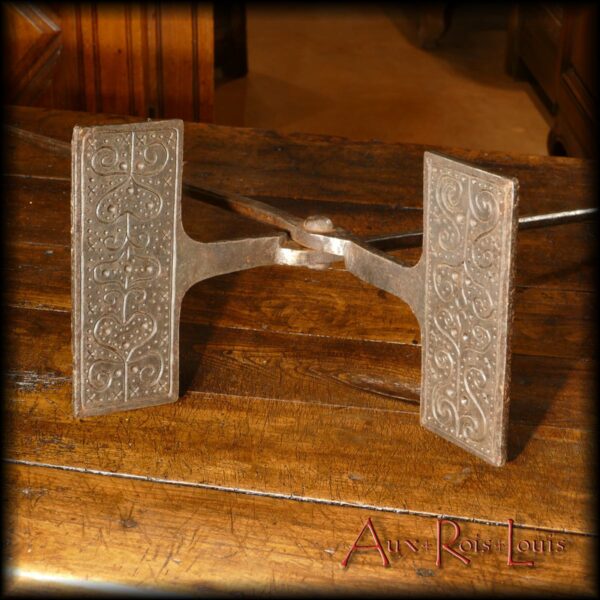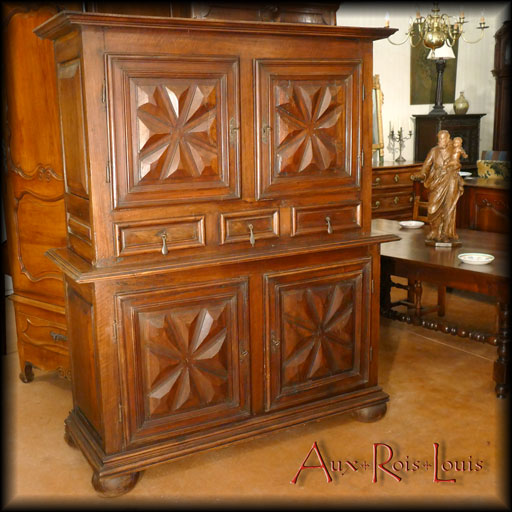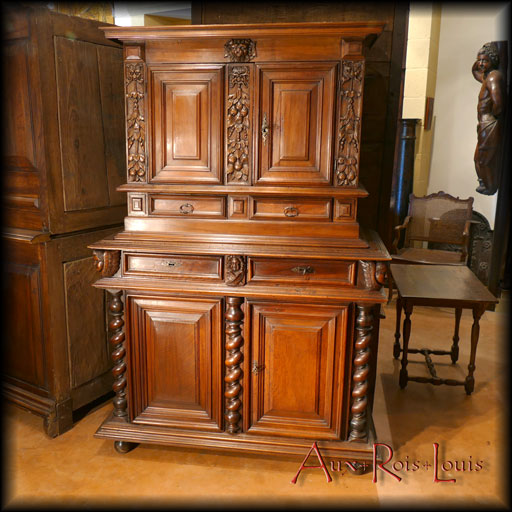Knight’s Oak Armour Chest – 15th Century – High Middle Ages – Périgord – [ME148]
AUX-ROIS-LOUIS’S TREASURES FILMING AT CHÂTEAU DE BIRON IN PÉRIGORD FOR THE SERIES ‘FORTUNE DE FRANCE’ Adapted from Robert Merle’s literary fresco, a writer native to Sarlat, the “Fortune de France” series directed by Christopher Thomson took up residence at Château de Biron, seat of one of the oldest baronies in Périgord, in spring 2023. It…

![Knight’s Oak Armour Chest – 15th Century – High Middle Ages – Périgord – [ME148] Impressive in size, this oak chest comes from a fortress in Périgord. It remains a testament to its past grandeur. Its mission was, in its time, to welcome back from battles the weapons and armour of the Knight Master of the house. It is rare to be able to observe this type of castle furniture, as very few of its comrades-in-arms were produced and most have now disappeared.](https://www.aux-rois-louis.com/wp-content/uploads/2024/04/ME148_P1680364-600x600.webp)
![Monoxyl Poplar Barrel – 19th Century – South West – [MP055] This type of barrel was dedicated to storing and maturing brandy produced on the estate, often from prunes in the South West. Its particularity lies in being monoxyl, meaning it was carved from a single trunk of poplar. This trunk was still green, allowing the two rounded bottoms, put in place during fabrication, to be completely trapped in the groove as the wood naturally dried. An ingenious process ensuring the barrel's watertightness and preserving its precious beverage.](https://www.aux-rois-louis.com/wp-content/uploads/2024/02/MP055_P1680234-600x600.webp)
![Oak and Embossed Leather Armchair – Louis XIII – 17th Century – Aquitaine – [ME128] The sturdy structure of this Louis XIII armchair is softened by bead turnings that adorn the armrests, armrest supports, and base. The backrest and seat are upholstered in embossed leather known as "Cordovan," revealing lush patterns of birds, leaves, and fruits.](https://www.aux-rois-louis.com/wp-content/uploads/2024/01/ME128_P1680308-600x600.webp)

![Royal Cast Iron Fireplace Plate – 17th Century – Périgord – [ME113] Impressively sized, this fireplace plate from the renowned foundries of Périgord showcases traditional royal heraldry, featuring a crown surrounded by fleur-de-lis and pine cones, symbolizing longevity. Cast in 1644, the inclusion of this date in its design adds to its historical appeal and authenticity.](https://www.aux-rois-louis.com/wp-content/uploads/2023/09/ME113_plaque_de_cheminee-600x600.webp)
![Cherry Wood Salon Table – Louis XIV – 18th Century – South West – [ME112] Here is a small cherry wood salon table commissioned by a castle in Périgord in the 18th century. It follows the codes of the Louis XIV style, featuring a moulded balustrade base connected by an H-shaped stretcher and blackened mouldings on the side rails. It has a drawer that spans its entire width.](https://www.aux-rois-louis.com/wp-content/uploads/2023/09/ME112_654-600x600.webp)
![Glazed Terracotta Oil Barrel – 19th Century – Saintonge – [PA080] This oil barrel comes from the renowned pottery center of La Chapelle-des-Pots, located in the former province of Charentes, known as Saintonge. Exclusively in Saintonge, from the Middle Ages onward, these barrel-shaped potteries were crafted using the beautiful local clay, reserving walnut oil for the lighting of each household.](https://www.aux-rois-louis.com/wp-content/uploads/2023/11/PA080_P1670098-600x600.webp)
![Oak Dining Table – Louis XIII – 17th Century – Corrèze – [ME107] This Louis XIII oak dining table comes from the Château de Turenne in Corrèze. In the 17th century, comfortable furniture was a privilege reserved for the nobility. While household staff dined standing at a high serving table, the masters of the house and their guests could comfortably sit around this well-proportioned table.](https://www.aux-rois-louis.com/wp-content/uploads/2023/11/ME107_P1660609-600x600.webp)
![Oak countryside table-desk – 19ᵗʰ century – Sarlat district in Périgord Noir – [MP053] This countryside "bureau" has all the distinctive features of those used in th XIXth century to collect the "octroi" when goods arrived in towns on market day. Its rustic solid oak structure rests upon a H-shaped stand off. It has a large drawer one could keep receipts and money.](https://www.aux-rois-louis.com/wp-content/uploads/2023/12/MP053_P1670159-600x600.webp)
![Natural Oak End-of-Bed Chest – 18th Century – South West – [MP046] Offered as part of the bride's dowry by her father, this natural oak chest adorned with tulips and a country bouquet served two purposes in the 18th century: to hold the personal effects of the young bride and to allow the couple to sit at the foot of their bed in complete intimacy. Hence its name "end-of-bed chest."](https://www.aux-rois-louis.com/wp-content/uploads/2023/06/MP046_589c-600x600.webp)
![Petrified Oil Jar – 19th Century – Saintonge / Charente – [PA077] Statufied and adorned with an emerald scarf, its gentle belly fears no ravages of time. On the contrary, it enhances it, turning this Charente pottery into a star jar, or dare I say, an authentic oil of the upscale districts.](https://www.aux-rois-louis.com/wp-content/uploads/2023/07/PA077_P1660669-600x600.webp)
![Bell Bronze Pie Dish – 19th Century – Southwest – [MP043] Here is a pie dish that has the particularity of being cast right after a church bell, in order not to waste any of the molten metal. Therefore, it is made of the same bronze and can be considered the little sister of a bell, just a few minutes apart, though not an exact twin.](https://www.aux-rois-louis.com/wp-content/uploads/2023/06/MP043_570-600x600.webp)

![Musician’s Lectern in Walnut – Late 18th century – Southwest region of France – [ME109] Here is an antique musician's lectern made of walnut from the 18th century in the Southwest region of France. It features a double openwork music stand resting on a solid wooden tablet, which contributes to its stability. Its base consists of three legs arranged in the manner of tree roots, ensuring its balance.](https://www.aux-rois-louis.com/wp-content/uploads/2023/07/ME0109_P1660615-600x600.webp)
![Louis XVI cherrywood jump chest from the 18th century – South West of France – [ME086] This Louis XVI chest of drawers is referred to as a "jump chest" due to its unusual height of its feet. Originating from the Provinces located in the South West region of the Kingdom of France, Guyenne and Gascony, this unique, sturdy and refined piece was made in the 18th century from thick cherrywood boards.](https://www.aux-rois-louis.com/wp-content/uploads/2023/01/ME086_P1660303-600x600.webp)
![Louis XIII style walnut reception table – 19th century – Périgord – [ME092] Louis XIII style walnut reception table – 19th century – Périgord – [ME092]](https://www.aux-rois-louis.com/wp-content/uploads/2022/12/ME092_491-600x600.webp)

![Walnut drop-leaf writing desk – 18th century – Périgord – [ME090] Drop-leaf secretary made in Périgord in the 18th century in beautiful walnut boards. It is composed of a crossbow chest of drawers with two large drawers, surmounted by a sloping flap that opens to become a writing desk.](https://www.aux-rois-louis.com/wp-content/uploads/2022/12/ME090_P1660457b-600x600.webp)
![Walnut community table – 19th century – South West of France – [ME088] Large walnut community table from a monastery in the South West of France. It is three meters long and can easily accommodate a dozen guests.](https://www.aux-rois-louis.com/wp-content/uploads/2022/12/ME088_P1660439-600x600.webp)
![Kettle, pie dish and decaliter jug in red copper – 18ᵉ century – South West – [MP035] [MP036] [MP037] Three copper containers of exceptional size: an enormous kettle, the matching pie dish and an equally imposing pitcher. All are in red copper and date from the 18th century, a period during which they were manufactured using the same processes in the South West of France.](https://www.aux-rois-louis.com/wp-content/uploads/2022/10/ME035-036-037_426-600x600.webp)
![Chest of Maison Forte in blond walnut – 17th century – Périgord – [ME078] Chest in blond walnut from the 17th century, from a Maison Forte du Périgord. It is decorated with a succession of eight projecting double tables or "chocolate plates", a typical Louis XIII motif. These motifs carved in the mass are two in number on each side and four on the front.](https://www.aux-rois-louis.com/wp-content/uploads/2022/09/ME078_P1660152-600x600.webp)
![Country chest of drawers in cherry wood – 18ᵗʰ century – Périgord – [ME080] Chest of drawers in cherry wood with four drawers on its curved front, two large at the bottom and two smaller at the top placed side by side. It was made in Périgord in the 18th century in thick cherry boards and rests on two scrolled legs at the front and two straight legs at the back.](https://www.aux-rois-louis.com/wp-content/uploads/2022/09/ME080_P1660186-600x600.webp)
![Chest of Knight in walnut – 18ᵗʰ century – Périgord – [ME081] Large walnut chest with straight lines ordered and shaped in the County of Périgord in the 18th century. This geographical origin is attested by a typically Périgord motif of an inverted V which houses the keyhole. The ironwork, lock, hinges and handles are all original.](https://www.aux-rois-louis.com/wp-content/uploads/2022/08/ME081_253-600x600.webp)
![Small two-piece walnut sideboard – 18ᵗʰ century – South West France – [ME073] Small two-piece sideboard made in the 18th century in the South West of France. It has a cornice, a picture rail and two largely molded drawers, four doors decorated with diamond points and it rests on two straight feet at the back and two onion feet at the front.](https://www.aux-rois-louis.com/wp-content/uploads/2022/08/ME073_P1660102n-600x600.webp)
![Walnut bonnetière – Louis XIV – 17ᵗʰ century – Périgord – [ME082] Walnut bonnetière – Louis XIV – 17ᵗʰ century – Périgord – [ME082]](https://www.aux-rois-louis.com/wp-content/uploads/2022/08/ME082_P1660256-600x600.webp)
![Louis XV Mirror Gilded Wood Louis XV mirror – gilded wood – 18ᵗʰ century – South West – [ME085]](https://www.aux-rois-louis.com/wp-content/uploads/2022/06/ME085_P1660289-600x600.webp)

![Small vat in cast iron for the soup Small vat for the soup in cast iron – 17ᵗʰ century – Fonderies du Périgord – [ME077]](https://www.aux-rois-louis.com/wp-content/uploads/2022/05/ME077_P1660136-600x600.jpg)
![Large cast iron vat for laundry Large cast iron vat for laundry – 16ᵗʰ century – Fonderies du Périgord – [ME076]](https://www.aux-rois-louis.com/wp-content/uploads/2022/05/ME076_P1660128-600x600.jpg)
![Sugar boiler for the Colonies – 16ᵗʰ century – Fonderies du Périgord – [ME075] Sugar boiler for the Colonies – 16ᵗʰ century – Fonderies du Périgord – [ME075]](https://www.aux-rois-louis.com/wp-content/uploads/2022/05/ME075_135-600x600.jpg)
![ME079_P1660184det Cast iron fireback – Louis XV – 18ᵗʰ century – South-West – [ME079]](https://www.aux-rois-louis.com/wp-content/uploads/2022/04/ME079_P1660184det-600x600.jpg)
![Walnut sideboard – 18ᵗʰ century – South-West – [MP030]](https://www.aux-rois-louis.com/wp-content/uploads/2022/04/MP030_740-600x600.jpg)
![Louis XIII credenza in walnut – 17ᵗʰ century – South-West – [ME071]](https://www.aux-rois-louis.com/wp-content/uploads/2022/03/ME071_P1650727x900-600x600.jpg)

![Terracotta ham pot – 19th century – Charente – [PA067]](https://www.aux-rois-louis.com/wp-content/uploads/2022/02/PA067_715-600x600.jpg)
![Folk art chestnut chest – 18th century – Béarn – [MP027]](https://www.aux-rois-louis.com/wp-content/uploads/2022/02/MP027_689x800-600x600.jpg)
![Sideboard chest – Louis XV – 18ᵗʰ century – South West France - [ME070]](https://www.aux-rois-louis.com/wp-content/uploads/2021/12/ME070_P1650586x900-600x600.jpg)
![Small walnut sideboard – Louis XIV – 17ᵗʰ century – Périgord – [ME069]](https://www.aux-rois-louis.com/wp-content/uploads/2021/12/ME069_P1650574x900-600x600.jpg)
![Cherry wood farm table – 19th century – Périgord – [MP024]](https://www.aux-rois-louis.com/wp-content/uploads/2021/11/MP024_125x900-600x600.jpg)

![Jam cabinet in cheery – late 18th century – Périgord – [MP023]](https://www.aux-rois-louis.com/wp-content/uploads/2021/11/MP023_084x900-600x600.jpg)
![Two water jugs – 19th century – Les Landes – [PA060] [PA061]](https://www.aux-rois-louis.com/wp-content/uploads/2021/11/PA060_61_099x900-600x600.jpg)
![Half-chest of drawers in cherry wood – 18th century – South West – [ME059]](https://www.aux-rois-louis.com/wp-content/uploads/2021/10/ME059_P1600975-600x600.jpg)
![Three water jugs – 19th century – Périgord – [PA055] [PA056] [PA057]](https://www.aux-rois-louis.com/wp-content/uploads/2021/10/PA055-56-57_P1600970-600x600.jpg)
![Two oil jugs - 19ᵗʰ century - Périgord - [PA053] [PA054]](https://www.aux-rois-louis.com/wp-content/uploads/2021/10/PA053-54_P1600961-600x600.jpg)
![Cast iron andirons - 18th century - Périgord - [ME062]](https://www.aux-rois-louis.com/wp-content/uploads/2021/09/ME062_013-600x600.jpg)
![ME061_P1610002 Walnut dresser – 17ᵗʰ century – South West France – [ME061]](https://www.aux-rois-louis.com/wp-content/uploads/2021/08/ME061_P1610002-600x600.jpg)







![ME053_P1600527 Office cabinet in walnut - Louis XIII - 17th century - Périgord - [ME053]](https://www.aux-rois-louis.com/wp-content/uploads/2021/04/ME053_P1600527-600x600.jpg)
![MP020_P1600516x900 Louis XV style country sideboard in walnut, oak and elm – 19ᵗʰ century – South West – [MP020]](https://www.aux-rois-louis.com/wp-content/uploads/2021/04/MP020_P1600516x900-600x600.jpg)
![ME052_P1600504 Curved chest of drawers in nuanced blond walnut – 18ᵗʰ century – Périgord - [ME052]](https://www.aux-rois-louis.com/wp-content/uploads/2021/04/ME052_P1600504-600x600.jpg)
![MP019_P1600496 Vaisselier dresser-drainer in cherrywood – 19ᵗʰ century – South West – [MP019]](https://www.aux-rois-louis.com/wp-content/uploads/2021/04/MP019_P1600496-600x600.jpg)
![ME051_P1600475 Renaissance style chest in walnut - 17ᵗʰ century - Périgord - [ME051]](https://www.aux-rois-louis.com/wp-content/uploads/2021/04/ME051_P1600475-600x600.jpg)
![ME050_464 Shrunken two bodies sideboard in walnut - Louis XIII - Périgord - [ME050]](https://www.aux-rois-louis.com/wp-content/uploads/2021/04/ME050_464-600x600.jpg)
![MP018_P1600485 Beech butcher's block – End of 19ᵗʰ century – South West – [MP018]](https://www.aux-rois-louis.com/wp-content/uploads/2021/04/MP018_P1600485-600x600.jpg)
![ME049_P1600325 Mazarin desk in walnut - Louis XIV - South West - [ME049]](https://www.aux-rois-louis.com/wp-content/uploads/2021/02/ME049_P1600325-600x600.jpg)
![ME048_P1600241_800x800 Louis XIII style oak table - 20th century - Périgord - [ME048]](https://www.aux-rois-louis.com/wp-content/uploads/2021/02/ME048_P1600241_800x800-600x600.jpg)
![ME045_P1600266 Louis XVI walnut chest of drawers – Late 18ᵗʰ century – South West – [ME045]](https://www.aux-rois-louis.com/wp-content/uploads/2021/02/ME045_P1600266-600x600.jpg)
![MP015_P1600280 Manka, oak sideboard – 18ᵗʰ century – Basque Country – [MP015]](https://www.aux-rois-louis.com/wp-content/uploads/2021/02/MP015_P1600280-600x600.jpg)
![MP017_P1600257 Oval walnut cellar table – 18ᵗʰ century – Lot – [MP017]](https://www.aux-rois-louis.com/wp-content/uploads/2021/02/MP017_P1600257-600x600.jpg)
![ME039_P1600103 Louis XVI walnut chest of drawers – Late 18ᵗʰ century – Sud-Ouest – [ME039]](https://www.aux-rois-louis.com/wp-content/uploads/2020/11/ME039_P1600103-600x600.jpg)
![ME044_184 Pantalonnière cupboard in cherry wood – Louis XIV – 18ᵗʰ century – Gironde – [ME044]](https://www.aux-rois-louis.com/wp-content/uploads/2020/11/ME044_184-600x600.jpg)
![ME043_P1600159 Louis XV style “homme-debout” in walnut - 18ᵗʰ century - Périgord - [ME043]](https://www.aux-rois-louis.com/wp-content/uploads/2020/11/ME043_P1600159-600x600.jpg)
![P1600115c800 Mazarin desk in walnut, oak and pear – Louis XIV – 17ᵗʰ century – South-West – [ME040]](https://www.aux-rois-louis.com/wp-content/uploads/2020/10/P1600115c800-600x600.jpg)






![Walnut wood chest – 18ᵗʰ century – Bordeaux Region Walnut wood chest – 18ᵗʰ century – Bordeaux Region – [ME005]](https://www.aux-rois-louis.com/wp-content/uploads/2022/07/ME005_N04_P1350548_2-600x600.webp)
![Louis XIV walnut armoire – late 17ᵗʰ century – Périgord Louis XIV walnut armoire – late 17ᵗʰ century – Périgord – [ME002]](https://www.aux-rois-louis.com/wp-content/uploads/2022/07/ME002_P1500449carrex800-600x600.webp)

![Walnut coffer – 18ᵗʰ century – Périgord Walnut coffer – 18ᵗʰ century – Périgord – [ME010]](https://www.aux-rois-louis.com/wp-content/uploads/2022/07/ME010_N10_P1500391-600x600.webp)